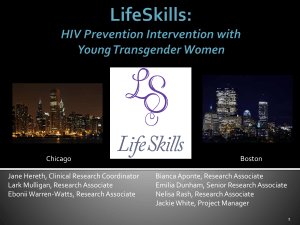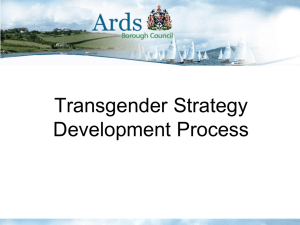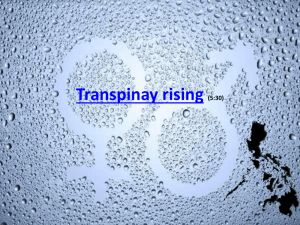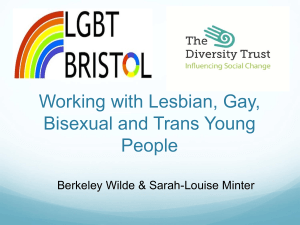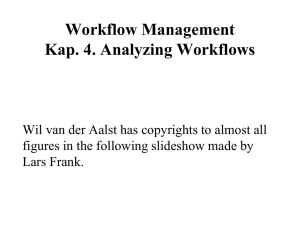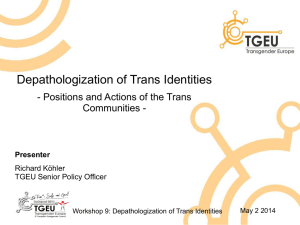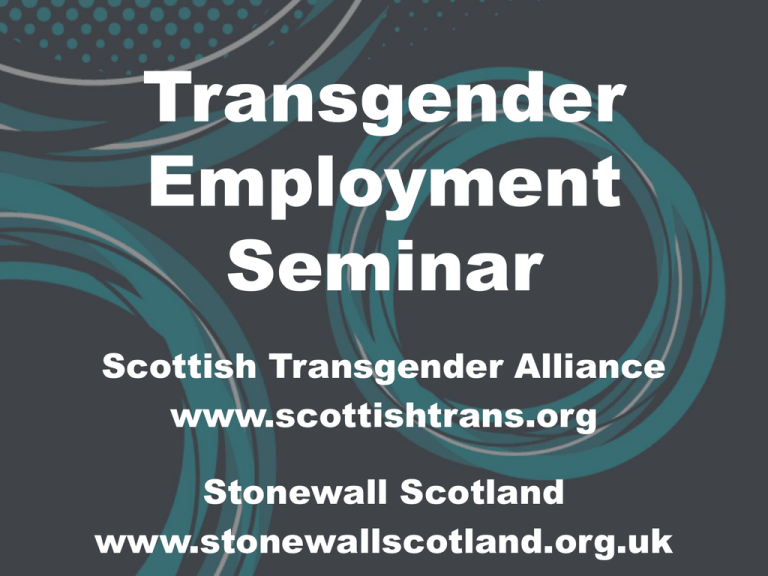
Transgender
Employment
Seminar
Scottish Transgender Alliance
www.scottishtrans.org
Stonewall Scotland
www.stonewallscotland.org.uk
Transgender
Equality at Work
Nathan Gale
Scottish Transgender Alliance
Nicola Swan
Stonewall Scotland
What do ‘transgender’
and ‘trans’ mean?
•
•
The terms transgender people and trans people are
both ‘umbrella’ terms.
Include all those whose gender identity and/or gender
expression differ from the sex they were labelled at birth.
•
Gender Identity = an individual’s internal self-perception
of their own gender.
•
Gender Expression = an individual’s external genderrelated physical appearance and behaviour.
Gender identity is not the
same as sexual orientation
•
•
•
•
Everyone has both a gender identity and also a sexual
orientation.
Your gender identity is your personal view of your own
gender.
Your sexual orientation is your personal view of who
you are attracted to.
Transgender people can be straight, gay, lesbian or
bisexual - just the same as everyone else!
How many people?
1000 people in
Scotland have
undergone gender
reassignment*
Over 10,000
transgender
people in
Scotland
* Estimated from ID change requests
Transgender Umbrella
Transsexual Women
(Male-To-Female)
Transsexual Men
(Female-To-Male)
Intersex People
Non-Binary
Gender People
Cross-Dressing People
Transsexual people
•
•
•
Transsexual people are usually distinguished from other
transgender people by their strong desire to live
completely and permanently as the gender opposite
to that which they were originally labelled at birth.
A male-to-female [MTF] trans woman is someone who
was labelled male at birth but has a female gender
identity and therefore transitions to live completely and
permanently as a woman.
A female-to-male [FTM] trans man is someone who
was labelled female at birth but has a male gender
identity and therefore transitions to live completely and
permanently as a man
Non-Binary Gender
•
•
•
•
•
Some people do not feel comfortable thinking of themselves
as simply either men or women. Instead they feel their gender
identity is more complicated to describe and is non-binary.
They may describe their gender identity as a mixture of
aspects of being a man and being a woman or alternatively
they may reject defining their gender at all.
Some non-binary gender people may undergo gender
reassignment in a similar way to transsexual people.
Some may use a combination of male and female names or
an androgynous name.
May also use various other terms such as genderqueer, thirdgender and androgyne.
Cross-dressing people
•
•
Some people cross-dress in public occasionally, or more
regularly, just because they feel more comfortable
expressing themselves in particular masculine or feminine
clothes.
Cross-dressing is more about gender expression rather
than gender identity. Most cross-dressing people are happy
with their birth gender and have no wish to transition
(undergo gender reassignment).
Intersex people
•
•
•
•
Sometimes a person’s external genitals, their internal
reproductive system or their chromosomes are in between
what is considered clearly male or female.
There are many different intersex conditions.
Most intersex people will self-identify clearly as men or as
women.
Doctors often guess which gender to assign to an intersex
baby. Sometimes the intersex person will turn out to have
a different gender identity from the doctor’s guess so the
intersex person may have to transition as an adult in a
similar way to transsexual people.
Gender Reassignment
•
•
A person has the protected characteristic of gender
reassignment if the person:
is proposing to undergo,
is undergoing
or has undergone
a process (or part of a process)
for the purpose of reassigning the person's sex
by changing physiological or other attributes of sex.
The Equality Act 2010 also provides protection for those
perceived as having, or associated with, the protected
characteristic of gender reassignment.
Name Change
•
•
It is usual to change the name and title on all
records (except their birth certificate) right at the
START of a person’s gender reassignment process.
All that is needed is a formal request for the change
signed by the person.
•
•
•
•
Gender Recognition
Certificate
An option available to transsexual people after they have
lived in their new gender for at least 2 years.
Not required to have had any surgery but required to end
any existing marriage or civil partnership.
Allows birth certificate to be corrected and to enter a
marriage or civil partnership in the new gender.
Possession of a gender recognition certificate provides
additional privacy protection by making it a criminal offence
to reveal someone’s gender recognition history without their
permission if that information was acquired in an official
capacity. There are various exceptions though, including
policing, receiving legal advice and in court.
In the Workplace
•
While still working in original gender role:
– Fear of ‘coming out’ as trans
– Risk of harassment from generalised comments
– Discretely seeking signs employer supports trans
equality
•
While out as trans or transitioning:
– Access to toilets and changing areas
– Respect and dignity, especially name and pronouns
– Empower to shape personal workplace transition
process
In the Workplace
• Staff with trans backgrounds
– Much more to them than being trans
– May need time off in the future for surgery
– Accessing references and achievements
– Right to privacy!
Good Practice Guidance
•
Always let trans people decide which toilet is the most
appropriate for them to use. Legally, they are allowed to.
•
Don’t make assumptions about how trans people view
gender – listen carefully to what they actually tell you
about their gender identity.
•
Don’t make assumptions about the sexual orientation of
a trans person or their partner, they could be
gay/lesbian, bisexual or straight.
Good Practice Guidance
•
Be proactive in demonstrating commitment to
transgender workplace equality and inclusion.
•
Always use a person’s preferred name and pronouns.
•
Change name and gender on records at first request.
•
•
Do not ask unnecessarily intrusive questions or make
comments about their physical body or gender history.
Maintain confidentiality about their gender history.
Ten steps to begin
workplace trans inclusion
1.
2.
3.
4.
5.
Include transgender equality as an equality strand in
general equality policies.
Ensure that transphobic bullying and harassment is
included in your workplace bullying and harassment policy.
Set up a staff LGBT support network and ensure that
transgender support info is available to staff.
Create a name and gender change procedural guidance
note to enable records to be quickly updated upon request.
Ensure your workplace absence management policy
includes allowing time off for gender reassignment medical
assessments and treatments.
Ten steps to begin
workplace trans inclusion
6.
Be proactive in supporting the right of trans people to use
workplace toilets in safety.
7. Identify a senior member of staff to champion transgender
equality.
8. Include transgender issues within your staff diversity
training programme.
9. Carry out a staff attitudes survey including questions on
attitudes towards transgender people.
10. State commitment to transgender equality in recruitment
advertising and by advertising in LGBT media.
Discussion of
Scenarios
James Morton & Nathan Gale
Scottish Transgender Alliance
Nicola Swan
Stonewall Scotland
Scenario A
•
•
Mike transitioned from female to male six years ago and
is not out to anyone about his gender history in his
current workplace which he joined two years ago. He
has finally received NHS funding approval for genital
surgery. He is terrified of revealing his gender history to
his direct line manager but needs to find out how to
arrange time off for his forthcoming surgery.
What good practice might his employer have already
implemented that could help Mike?
Points to Consider
•
•
•
•
What would be the safest and most confidential ways for
Mike to find out about taking time off for his surgery?
What level of detail does Mike’s direct line manager need
to know about his forthcoming surgery?
If Mike were to undergo four operation stages over an 18
month timescale, in what ways could absence
management and disability policies be relevant to him?
What further support and assistance might Mike need
beyond simply time off?
Scenario B
•
•
Three colleagues are discussing a television reality show:
– “She looked a bit masculine. Do you think she’s one of
those trannies?”
– “Aye, maybe, weirdos.”
– “Yeah, what a munter. Bet it was really a bloke.”
The conversation shifts to an individual who has recently
joined the team. One of the colleagues begins to
speculate:
– “Do you think Jane’s a tranny too?”
When does the conversation become inappropriate
and how should their line manager react?
Points to Consider
•
•
•
•
What does this conversation reveal about the workplace
culture?
How could it have been different?
Does whether or not Jane actually is a trans person make
any difference to how a manager should deal with the
conversation?
What are the potential consequences of this conversation
for the employer, Jane, the three colleagues, and other
employees who heard it?
Scenario C
•
•
You receive a request from another employer to provide
a reference for a Mr David Cunningham, sales assistant.
You check your records and find that the only sales
assistant with the same surname was a Miss Gemma
Cunningham.
How would you proceed with the reference request?
Points to Consider
•
•
•
•
Would you respond to the request straight away stating
that you only have record of Miss Gemma Cunningham?
Would you reply saying that you don’t have record of
having employed that person?
Would you ask for more details such as a date of birth or
National Insurance number?
Would you get in touch with the former employee and
find out whether the reference request relates to them?
Trans Monitoring
& Evidence
James Morton
Scottish Transgender Alliance
www.scottishtrans.org
Scottish Specific Duties
•
For the setting of public sector equality outcomes, its required
to consider relevant evidence relating to trans people.
•
When doing equality impact assessments, it’s required to
consider relevant evidence relating to trans people.
•
As part of gathering information on workforce composition it’s
required to take steps to gather evidence about numbers of
trans employees. These steps should involve careful
preparation stages rather than a rapid addition of new
monitoring questions.
Gathering Evidence
•
Can use a range of internal and external sources, such as:
–
–
–
–
–
–
–
–
–
•
Individual case studies
Staff attitude surveys and knowledge tests
Evaluation of policy implementation levels
Consulting staff groups and communities of interest
Reviewing complaints and grievances
Findings from quantitative and/or qualitative research
Diversity monitoring information and administrative data
Commissioning mystery shoppers
Information and advice from equality organisations.
You don’t need to gather evidence in exactly the same way for
each protected characteristic – do what works best for each.
Key Trans Evidence
GEO trans survey of 412 UK trans people in 2011 found:
• 88% cited workplace ignorance of trans issues as major problem
• 86% cited employers fearful of possible customer/client reaction
towards a transgender employee as a barrier in employment
• 50% had been harassed or discriminated against because of their
gender identity in their previous or current job
– 63% of those complained to manager
– 30% said their complaint was handled poorly
• 57% said their current or last employer did not have an employment
policy to support transgender employees.
• 31% said that gossip, as a threat to their privacy, had the greatest
impact on their life.
• 72% did not feel their current identity was secure from disclosure.
http://tinyurl.com/geotranssurvey
Key Trans Evidence
STA trans survey of 665 UK trans people in 2012 found:
• 55% have a HND/Degree or Post-Graduate Degree qualification
• 35% suspected they’d been turned down for a job due to being trans
– 26% more than once
– 1% within last week,17% within last year, 18% over 1 year ago
• 54% worry they’ll be turned down for a job in future due to being trans
• 39% are open about being trans at work
• 38% employed full time, 12% employed part-time, 12% self-employed
• 19% in education, 7% retired, 37% currently unemployed
• 52% experienced problems with work due to being trans
• 16% avoided applying for jobs due to fears of harassment/discrimination
• 9% had not provided references because of their gender history. 7% had
resigned from a job due to harassment or discrimination even though
they had no other job to go to.
Key Trans Evidence
• How supportive have the following been?
Not at all / Not very / Somewhat / Very
• My co-workers
30%
4%
(Not applicable as not ‘out’ 58%)
16%
19%
Not at all / Not very / Somewhat / Very
• My supervisor/boss 4%
3%
(Not applicable as not ‘out’ 55%)
14%
23%
STA Trans Quotes 2012
•
“I didn't feel safe enough to use the bathroom at my last job as a
result of being trans and people getting angry when I tried to use the
bathroom.”
•
“I was a senior manager at a software company, and the directors
could not deal with the thought that I might transition – so we agreed
redundancy as opposed to me taking them to tribunal. I got many
interviews but only vague explanations as to why I didn't get any
subsequent jobs.”
•
“Due to staff members and management being unable to accept my
transition, I was laid off after 17 years by a compromise agreement. I
feel I cannot apply for other jobs in same sector as it is not pleasant
for trans people.”
STA Trans Quotes 2012
•
“Found out from a friend who already worked somewhere I had been
turned down for that the manager felt "He/She'd be a huge
disruption to the rest of the staff. We'd have to make all sorts of
changes. I mean, which toilets would he/she use?!" (a direct quote,
I'm assured. Also of note is that there are unisex toilets on site).
Manager sounded really keen on me on the phone, loved my
experience, and answers to her questions. When I got there she
took one look at me and her face fell, she barely asked me any
questions and what she did ask was largely "How would you deal
with a customer who had a problem with you being... er... You
know." …Due to this kind of reaction at several interviews I've
stopped applying for customer facing jobs to avoid this kind of
treatment in future.”
Counting Heads
or Heads Rolling?
•
•
•
•
•
Do visible trans equality awareness raising and make
policies trans inclusive before asking employees to risk
disclosing their trans status on monitoring forms.
Work out how to analyse a question before asking it
Ensure anonymity and restrict access to raw data
Involve trans staff and external trans equality orgs in
monitoring design process
Ensure answering is clearly voluntary – especially at
recruitment stage
10 Suggested Steps
1. Start doing visible trans equality work and ensure
relevant employment policies are trans inclusive.
2. Arrange trans equality training to ensure that staff
responsible for monitoring are aware of complexity and
sensitivity of trans monitoring issues.
3. Examine your current monitoring data collection
process to determine levels of data security and
anonymity provided.
4. Seek guidance from a trans equality org to assist in
resolving any data security and anonymity issues.
10 Suggested Steps
5. Together with a trans equality org determine most
suitable question phrasing and clear rationale for
analysis and interpretation of responses.
6. Create a short public information sheet providing details
of how you will maintain data security and anonymity
and how the data will be stored, analysed and used.
7. Distribute information sheet and news of forthcoming
monitoring via external trans & LGBT groups and
internal staff networks.
8. Carry out the monitoring and analyse data received.
9. Review learning in partnership with a trans equality org.
10. Implement improvements.
Gender Identity
Monitoring Question
Many trans people get very offended by being directly asked
what their birth sex was. Therefore, STA recommends asking
how people currently think of themselves and avoiding asking
directly for original birth sex details unless absolutely essential
(such as in some health contexts).
We currently recommend asking:
• Which of the following describes how you think of
yourself?
Female
Male
In another way: _________________
Rather not say
Trans Monitoring
Questions
We originally recommended asking:
• Is your gender identity different to the sex you were assumed to be
at birth?
o Yes (Please describe difference:_________________ )
o No
o Rather not say
However, our testing in real life situations has revealed that these
alternative phrasings might be better able to reduce confusion due to
language barriers, learning difficulties and lack of awareness:
•
•
Is the current gender (or sex) you identity with different to the
gender (or sex) you were described as at birth?
Is your current gender (or sex) different to the gender (or sex)
you were born with?
Gender Reassignment Status
The EHRC has suggested the following pair of questions but we are concerned
about the level of phrasing complexity and therefore recommend caution:
• Have you gone through any part of a process (including thoughts or actions)
to change from the sex you were described as at birth to the gender you
identify with, or do you intend to?
(This could include changing your name, wearing different clothes, taking
hormones or having gender reassignment surgery).
o Yes
o No
• (If Yes) Continuing to think about these examples, which of the following
options best applies to you?
o I am thinking about going through this process
o I am currently going through this process
o I have already been through this process
o I have been through this process, then changed back
o None of the above: _____________
o I prefer not to say
More specific categories
Where a respondent indicates either that their current gender differs from
their birth sex in some way or that they identify other than simply male or
female, you may find it useful to ask them what specific terms they use.
• Which of the following describes how you think of yourself?
Man with a transsexual history
Woman with a transsexual history
Trans man
Trans woman
Gender variant/ non-binary person
Cross dressing/ transvestite person
Intersex person
In another way: _______________________
Rather not say
Q&A
Scottish Transgender Alliance
www.scottishtrans.org
Stonewall Scotland
www.stonewallscotland.org.uk

